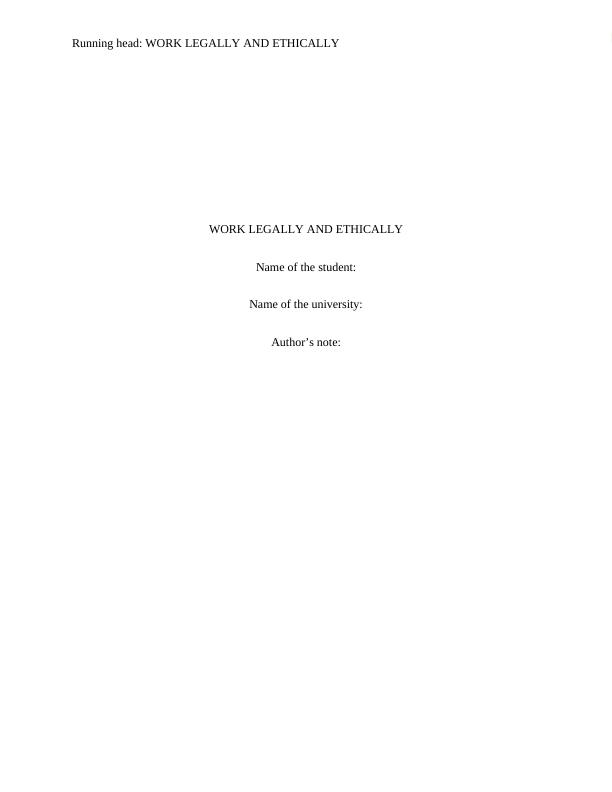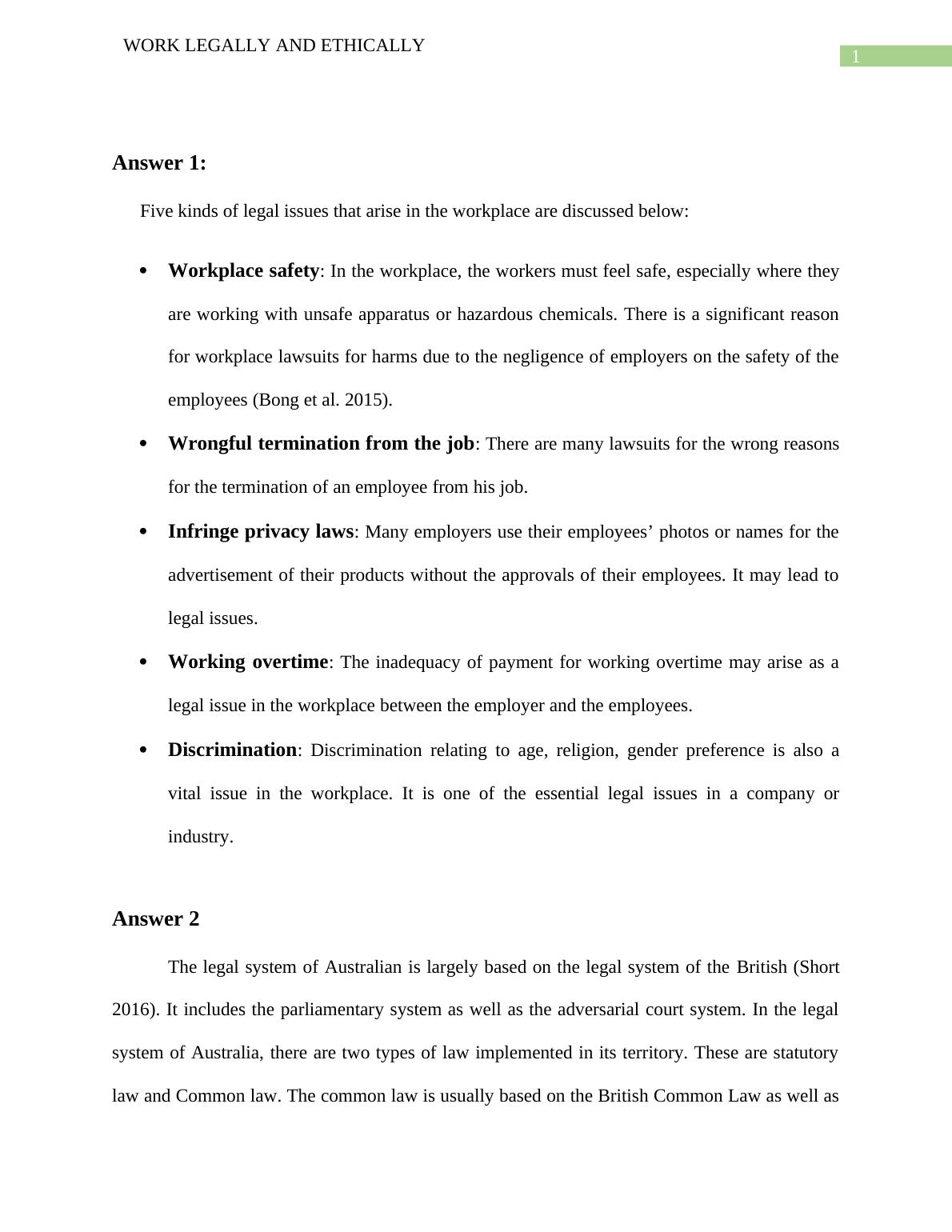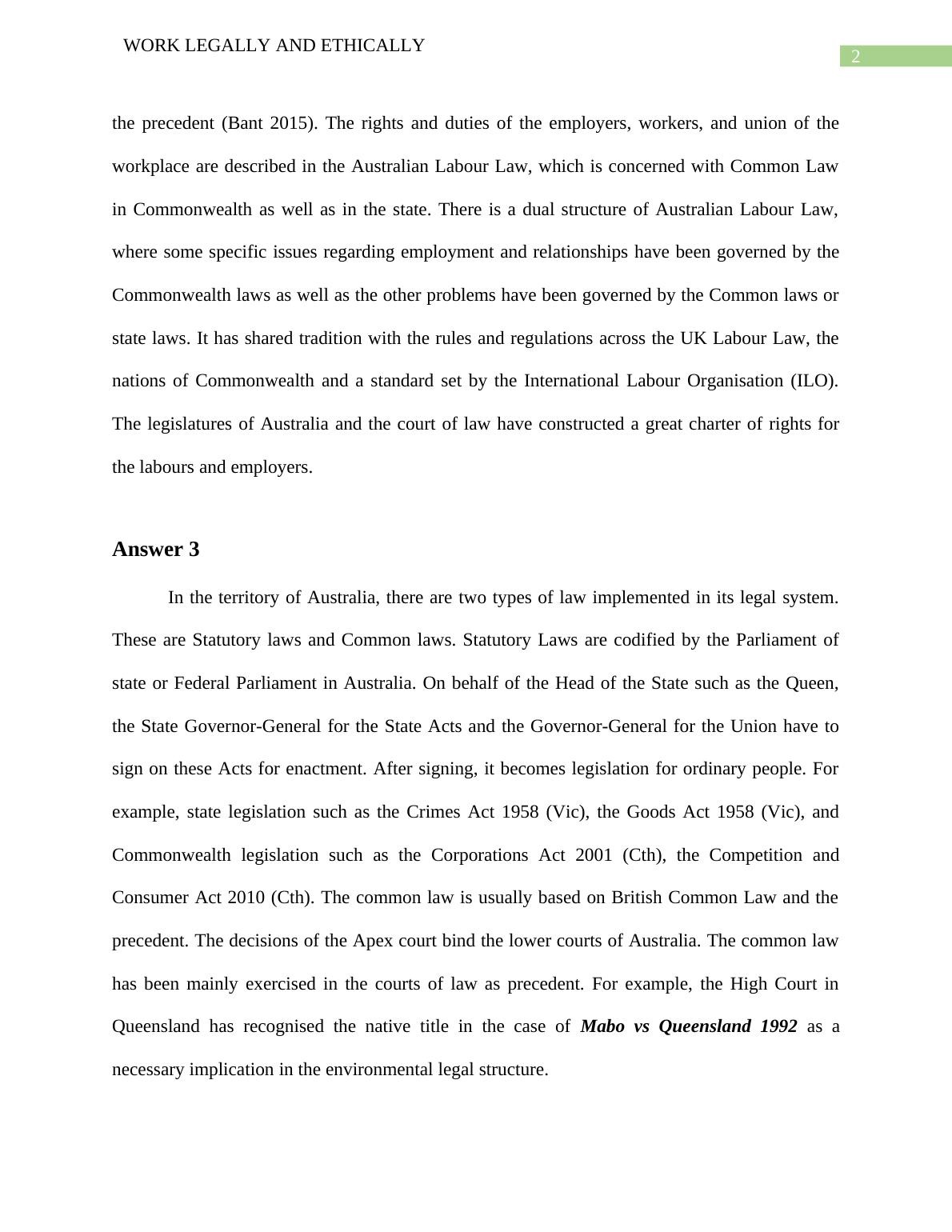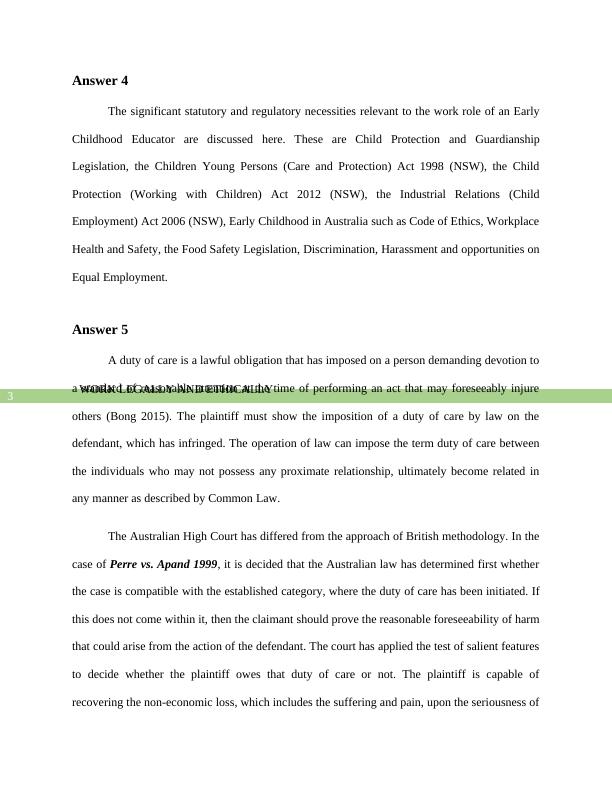Work Legally and Ethically
Added on 2022-08-27
18 Pages4694 Words20 Views
0Running head: WORK LEGALLY AND ETHICALLY
WORK LEGALLY AND ETHICALLY
Name of the student:
Name of the university:
Author’s note:
WORK LEGALLY AND ETHICALLY
Name of the student:
Name of the university:
Author’s note:

WORK LEGALLY AND ETHICALLY
1
Answer 1:
Five kinds of legal issues that arise in the workplace are discussed below:
Workplace safety: In the workplace, the workers must feel safe, especially where they
are working with unsafe apparatus or hazardous chemicals. There is a significant reason
for workplace lawsuits for harms due to the negligence of employers on the safety of the
employees (Bong et al. 2015).
Wrongful termination from the job: There are many lawsuits for the wrong reasons
for the termination of an employee from his job.
Infringe privacy laws: Many employers use their employees’ photos or names for the
advertisement of their products without the approvals of their employees. It may lead to
legal issues.
Working overtime: The inadequacy of payment for working overtime may arise as a
legal issue in the workplace between the employer and the employees.
Discrimination: Discrimination relating to age, religion, gender preference is also a
vital issue in the workplace. It is one of the essential legal issues in a company or
industry.
Answer 2
The legal system of Australian is largely based on the legal system of the British (Short
2016). It includes the parliamentary system as well as the adversarial court system. In the legal
system of Australia, there are two types of law implemented in its territory. These are statutory
law and Common law. The common law is usually based on the British Common Law as well as
1
Answer 1:
Five kinds of legal issues that arise in the workplace are discussed below:
Workplace safety: In the workplace, the workers must feel safe, especially where they
are working with unsafe apparatus or hazardous chemicals. There is a significant reason
for workplace lawsuits for harms due to the negligence of employers on the safety of the
employees (Bong et al. 2015).
Wrongful termination from the job: There are many lawsuits for the wrong reasons
for the termination of an employee from his job.
Infringe privacy laws: Many employers use their employees’ photos or names for the
advertisement of their products without the approvals of their employees. It may lead to
legal issues.
Working overtime: The inadequacy of payment for working overtime may arise as a
legal issue in the workplace between the employer and the employees.
Discrimination: Discrimination relating to age, religion, gender preference is also a
vital issue in the workplace. It is one of the essential legal issues in a company or
industry.
Answer 2
The legal system of Australian is largely based on the legal system of the British (Short
2016). It includes the parliamentary system as well as the adversarial court system. In the legal
system of Australia, there are two types of law implemented in its territory. These are statutory
law and Common law. The common law is usually based on the British Common Law as well as

WORK LEGALLY AND ETHICALLY
2
the precedent (Bant 2015). The rights and duties of the employers, workers, and union of the
workplace are described in the Australian Labour Law, which is concerned with Common Law
in Commonwealth as well as in the state. There is a dual structure of Australian Labour Law,
where some specific issues regarding employment and relationships have been governed by the
Commonwealth laws as well as the other problems have been governed by the Common laws or
state laws. It has shared tradition with the rules and regulations across the UK Labour Law, the
nations of Commonwealth and a standard set by the International Labour Organisation (ILO).
The legislatures of Australia and the court of law have constructed a great charter of rights for
the labours and employers.
Answer 3
In the territory of Australia, there are two types of law implemented in its legal system.
These are Statutory laws and Common laws. Statutory Laws are codified by the Parliament of
state or Federal Parliament in Australia. On behalf of the Head of the State such as the Queen,
the State Governor-General for the State Acts and the Governor-General for the Union have to
sign on these Acts for enactment. After signing, it becomes legislation for ordinary people. For
example, state legislation such as the Crimes Act 1958 (Vic), the Goods Act 1958 (Vic), and
Commonwealth legislation such as the Corporations Act 2001 (Cth), the Competition and
Consumer Act 2010 (Cth). The common law is usually based on British Common Law and the
precedent. The decisions of the Apex court bind the lower courts of Australia. The common law
has been mainly exercised in the courts of law as precedent. For example, the High Court in
Queensland has recognised the native title in the case of Mabo vs Queensland 1992 as a
necessary implication in the environmental legal structure.
2
the precedent (Bant 2015). The rights and duties of the employers, workers, and union of the
workplace are described in the Australian Labour Law, which is concerned with Common Law
in Commonwealth as well as in the state. There is a dual structure of Australian Labour Law,
where some specific issues regarding employment and relationships have been governed by the
Commonwealth laws as well as the other problems have been governed by the Common laws or
state laws. It has shared tradition with the rules and regulations across the UK Labour Law, the
nations of Commonwealth and a standard set by the International Labour Organisation (ILO).
The legislatures of Australia and the court of law have constructed a great charter of rights for
the labours and employers.
Answer 3
In the territory of Australia, there are two types of law implemented in its legal system.
These are Statutory laws and Common laws. Statutory Laws are codified by the Parliament of
state or Federal Parliament in Australia. On behalf of the Head of the State such as the Queen,
the State Governor-General for the State Acts and the Governor-General for the Union have to
sign on these Acts for enactment. After signing, it becomes legislation for ordinary people. For
example, state legislation such as the Crimes Act 1958 (Vic), the Goods Act 1958 (Vic), and
Commonwealth legislation such as the Corporations Act 2001 (Cth), the Competition and
Consumer Act 2010 (Cth). The common law is usually based on British Common Law and the
precedent. The decisions of the Apex court bind the lower courts of Australia. The common law
has been mainly exercised in the courts of law as precedent. For example, the High Court in
Queensland has recognised the native title in the case of Mabo vs Queensland 1992 as a
necessary implication in the environmental legal structure.

WORK LEGALLY AND ETHICALLY
3
Answer 4
The significant statutory and regulatory necessities relevant to the work role of an Early
Childhood Educator are discussed here. These are Child Protection and Guardianship
Legislation, the Children Young Persons (Care and Protection) Act 1998 (NSW), the Child
Protection (Working with Children) Act 2012 (NSW), the Industrial Relations (Child
Employment) Act 2006 (NSW), Early Childhood in Australia such as Code of Ethics, Workplace
Health and Safety, the Food Safety Legislation, Discrimination, Harassment and opportunities on
Equal Employment.
Answer 5
A duty of care is a lawful obligation that has imposed on a person demanding devotion to
a standard of reasonable attention at the time of performing an act that may foreseeably injure
others (Bong 2015). The plaintiff must show the imposition of a duty of care by law on the
defendant, which has infringed. The operation of law can impose the term duty of care between
the individuals who may not possess any proximate relationship, ultimately become related in
any manner as described by Common Law.
The Australian High Court has differed from the approach of British methodology. In the
case of Perre vs. Apand 1999, it is decided that the Australian law has determined first whether
the case is compatible with the established category, where the duty of care has been initiated. If
this does not come within it, then the claimant should prove the reasonable foreseeability of harm
that could arise from the action of the defendant. The court has applied the test of salient features
to decide whether the plaintiff owes that duty of care or not. The plaintiff is capable of
recovering the non-economic loss, which includes the suffering and pain, upon the seriousness of
3
Answer 4
The significant statutory and regulatory necessities relevant to the work role of an Early
Childhood Educator are discussed here. These are Child Protection and Guardianship
Legislation, the Children Young Persons (Care and Protection) Act 1998 (NSW), the Child
Protection (Working with Children) Act 2012 (NSW), the Industrial Relations (Child
Employment) Act 2006 (NSW), Early Childhood in Australia such as Code of Ethics, Workplace
Health and Safety, the Food Safety Legislation, Discrimination, Harassment and opportunities on
Equal Employment.
Answer 5
A duty of care is a lawful obligation that has imposed on a person demanding devotion to
a standard of reasonable attention at the time of performing an act that may foreseeably injure
others (Bong 2015). The plaintiff must show the imposition of a duty of care by law on the
defendant, which has infringed. The operation of law can impose the term duty of care between
the individuals who may not possess any proximate relationship, ultimately become related in
any manner as described by Common Law.
The Australian High Court has differed from the approach of British methodology. In the
case of Perre vs. Apand 1999, it is decided that the Australian law has determined first whether
the case is compatible with the established category, where the duty of care has been initiated. If
this does not come within it, then the claimant should prove the reasonable foreseeability of harm
that could arise from the action of the defendant. The court has applied the test of salient features
to decide whether the plaintiff owes that duty of care or not. The plaintiff is capable of
recovering the non-economic loss, which includes the suffering and pain, upon the seriousness of

End of preview
Want to access all the pages? Upload your documents or become a member.
Related Documents
Employment Relations for Organisation Effectivenesslg...
|15
|5426
|288
Report On Political System Of Australialg...
|17
|3444
|230
Access and Interpret Ethical Practice in Real Estatelg...
|12
|2609
|1
Australian Commercial Law: Analysis of Legal Systemslg...
|8
|2387
|146
Employment Relations in Australialg...
|9
|2728
|400
Management of Workplace Conflicts: Assessmentlg...
|30
|6763
|38
